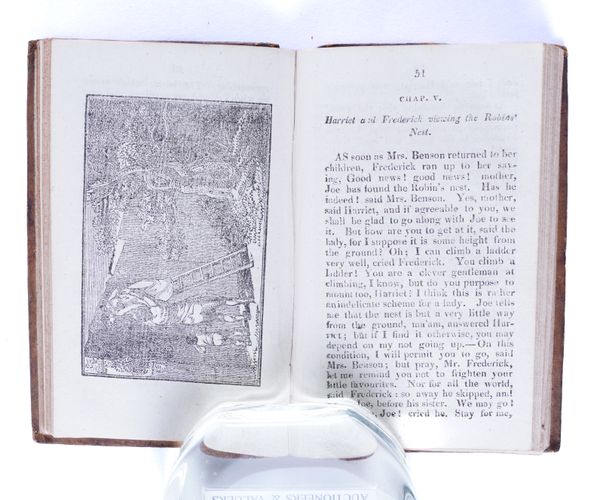TRIMMER, Sarah (1741-1810). History of the Robins, Designed for the Instruction of Children respecting the Treatment of Animals, Dublin, 1819, 12mo, woodcut frontispiece and 5 full-page illustrations, vignettes, contemporary calf (rubbed).
| Estimate: | £70 - £100 |
| Hammer price: | £35 |
TRIMMER, Sarah (1741-1810). History of the Robins, Designed for the Instruction of Children Respecting their Treatment of Animals, by Mrs. Trimmer. Dublin: Printed by John Jones, 1819. 12mo (140 x 90mm). Woodcut frontispiece, vignette on title, 5 full-page woodcut illustrations, vignettes (ink spot on title not touching letters). Contemporary calf, spine lettered and ruled in gilt (joints split, quite heavily rubbed). Provenance: "Boyd Francis Alexander from his [illegible word] Aunt, E. J. G. Alexander, Sept. 9th" (old inscription at head of title); "Marion Davis from her Father, Boyd F. Alexander [illegible word], 4th June 1915" (inscription on front free endpaper). "The following little Book supposes the sentiments and affections of a good father and mother, and a family of children, to be possessed by a nest of Redbreasts, and was written with the benevolent design of teaching the young to be tender-hearted and compassionate, not only to the feathered race, but to all animal creation" (from the Preface). Some have attributed the illustrations to Thomas Bewick, which may be plausible in the case of the small bird vignettes, less so in the full-page illustrations. Percy Muir, the bibliographer and historian of children's books, takes a very dim view of the author and the purpose of this little book which seems quite at odds with its apparent charm. "This preposterous woman [i.e. Mrs Trimmer] did produce one book that achieved an obstinate success. It was originally called Fabulous Histories, and was published by Longman in 1786. In a later edition the title was changed to the more familiar History of the Robins. It must have been written with more than one eye on the parents, the preface betrays the fact completely. The parent robins, she says, represent a loving mother and father of a human family, and although it is necessary that the little birds should be made to talk to one another, her aim is not to suggest the real subject or method of bird conversation, but 'to convey moral instruction' applicable to the children who read her book, while also inclining them against wanton cruelty to the animal creation. The constant preoccupation with cruelty to animals undoubtedly suggests a certain depravity in the children of the time." Obstinately, we rather like the book. See Percy Muir English Children's Books 1600-1900 p.87 & p.94.





